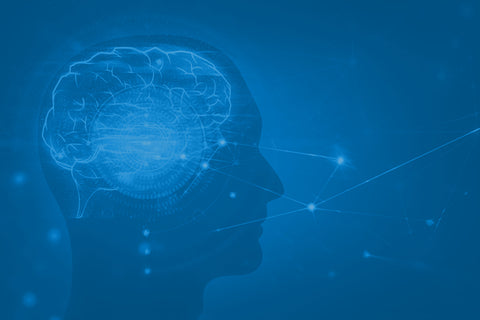
GABA decreases firing of neurons in the brain, relaxing and chilling out your brain (and you). But there is a paradox and a problem.
The paradox? You have to get excited before you can chill out.
The problem? GABA can’t penetrate the blood-brain barrier (BBB) to work its chillaxing magic despite what your supplements may tell you.
Read on to find out more about this major neurotransmitter, its many crucial functions in the central nervous system (CNS), and the solution(s) to both the problem and the paradox.
GABA's History
Eugene Roberts and Jorge Awapara discovered GABA in the CNS in 1950. GABA was known to have a metabolic role in plants and bacteria. Roberts and Awapara found that there is 1 mg of GABA per gram of CNS tissue. GABA was virtually undetectable in other tissues [7].
In 1953, Ernst Florey observed an unknown compound from a horse brain inhibiting a crayfish stretch inhibitor when administered exogenously. In later studies, Florey demonstrated that this unknown compound had the same effect on the patellar reflex in cats [7]. In 1957, Florey extracted and purified the compound which he identified to be GABA [7].
In the 1960s, additional studies showed that GABA abolished spontaneous action potentials in muscles. It was also found to be highly concentrated in inhibitory motor neurons, further proving its function as an inhibitory neurotransmitter.
How GABA Works
GABA is synthesized from glutamate by the enzyme glutamate decarboxylase with pyridoxal phosphate (vitamin B6) as a cofactor [1]. Glutamate is one of the most abundant amino acids in the body. Foods with high levels of glutamate include dairy products, meats, seafood, and mushrooms. It plays key roles in a variety of physiological functions, especially as an excitatory neurotransmitter in the brain. And herein lies the paradox: You need to get excited before you can chill (i.e., make GABA)!
When voltage-gated calcium channels open, GABA is released to bind to two different classes of GABA receptors:
- GABA-A receptors: an ionotropic receptor which increases chloride ion conductance in the cell in the presence of GABA [2]
- GABA-B receptors: increases postsynaptic potassium conductance and decreases presynaptic calcium conductance in the presence of GABA [2]
When bound to either of these receptors, GABA serves its primary inhibitory function. After being released from these receptors, GABA is degraded externally (outside the cell) or by GABA-transaminase.
There are also positive and negative allosteric modulators of GABA receptors. Allosteric modulators bind to the receptor to change the receptor’s response to stimuli. There are two main types of allosteric molecules. Positive allosteric modulators increase agonist affinity. This increases the response of the receptor by increasing the chance that the agonist (in this case, GABA) will bind to the receptor. Negative allosteric modulators decrease agonist affinity (which has the opposite effect of a positive allosteric modulator).
Positive allosteric modulators of GABA receptors include benzodiazepines, kava, and N-nicotinoyl-GABA. These modulators have sedative, anticonvulsant, anxiolytic, and muscle relaxant potential.
Interestingly, when the fetal brain is developing, GABA can serve an excitatory role as well. When GABA binds to a GABA-A receptor in the fetus, the cell becomes more likely to fire an action potential. This is due to lower extracellular versus intracellular concentrations of chloride in the developing brain.
GABA is also found in areas outside the CNS. For example, the pancreas creates and uses GABA to inhibit pancreatic alpha cells and stimulate beta-cell growth.
GABA's Key Benefits
Studies have shown that increasing GABA production or intake may have several key benefits, such as:
- Improve sleep quality [3]
- Decrease anxiety [3]
- Protect the brain (neuroprotective) [4]
- Neurological disorder prevention (suppresses neurodegeneration) [4]
- Decrease blood pressure [4]
While increasing GABA is primarily known for enhancing sleep quality and stress-relief, it also has other less known benefits. In one study, GABA exhibited a protective effect against neurotoxic-induced cell death [5]. GABA also suppresses neurodegeneration and improves memory along with other cognitive functions. In other studies, GABA also caused a dose-related decrease in blood pressure [6].
GABA Dosage
Effective dosing of GABA ranges from person to person. In a summary of case studies, lower doses of around 30 mg seem to affect autonomic markers for stress, while doses of 100 mg affect the central markers for stress [3]. For sleep, doses ranging from 100-300 mg may be efficacious in reducing sleep latency [3].
There are several drugs that mimic or increase GABA in the brain, including benzodiazepines and gabapentin, but very few supplements that do the same. This is because exogenous GABA taken as a supplement has very poor bioavailability and cannot penetrate the BBB on its own (despite what your supplement company may tell you) [8]. Remember the “problem” we discussed above? Well, this is it! Another problem is that most of these pharmaceutical drugs are highly addictive and/or induce tolerance.
But there’s good news! There are non-drug (and much safer!) solutions available, including an allosteric modulator called N-nicotinoyl-GABA which allows GABA to bypass the BBB, and kava (more below!).
GABA Safety
GABA itself is a very safe molecule, and the reported side effects are mild with intake. Some possible side effects include:
- Abdominal pain
- Drowsiness
- Headaches
Extreme caution is recommended if pairing GABA supplements with drugs such as benzodiazepines and alcohol, as such combinations can worsen potential side effects.
GABA In Our Products
Tro Calm is our precision dosed, pharmaceutical grade, and physician formulated buccal troche that will help you take the edge off, chill out, and quiet your mind. It has two ingredients that modulate the brain’s GABAergic system:
- N-nicotinoyl-GABA which crosses the BBB and increases GABA directly
- Kava which increases binding of GABA to its receptors
At low doses, these ingredients work synergistically and safely without risk of dependence or tolerance when used as directed. Tro Calm also contains CBD and CBG which modulate the endocannabinoid system.
The end result of this novel formula? ¼ troche will take the edge off and you’ll perform better, ½ troche and you’ll be more chill (think a glass or two of wine without the downside), ¾ to 1 full troche for full relaxation, full quieting of the mind, and deeper sleep. Tro Calm… And Carry On!
References
- Jewett BE, Sharma S. Physiology, GABA. [Updated 2021 Jul 26]. In: StatPearls [Internet]. Treasure Island (FL): StatPearls Publishing; 2022 Jan-. Available from: https://www.ncbi.nlm.nih.gov/books/NBK513311/
- Olsen RW, DeLorey TM. GABA Receptor Physiology and Pharmacology. In: Siegel GJ, Agranoff BW, Albers RW, et al., editors. Basic Neurochemistry: Molecular, Cellular and Medical Aspects. 6th edition. Philadelphia: Lippincott-Raven; 1999. Available from: https://www.ncbi.nlm.nih.gov/books/NBK28090/
- Hepsomali, P., Groeger, J. A., Nishihira, J., & Scholey, A. (2020). Effects of Oral Gamma-Aminobutyric Acid (GABA) Administration on Stress and Sleep in Humans: A Systematic Review. Frontiers in neuroscience, 14, 923. https://doi.org/10.3389/fnins.2020.00923
- Ngo, D. H., & Vo, T. S. (2019). An Updated Review on Pharmaceutical Properties of Gamma-Aminobutyric Acid. Molecules (Basel, Switzerland), 24(15), 2678. https://doi.org/10.3390/molecules24152678
- Cho, Y. R., Chang, J. Y., & Chang, H. C. (2007). Production of gamma-aminobutyric acid (GABA) by Lactobacillus buchneri isolated from kimchi and its neuroprotective effect on neuronal cells. Journal of microbiology and biotechnology, 17(1), 104–109.
- Kimura, M., Hayakawa, K., & Sansawa, H. (2002). Involvement of gamma-aminobutyric acid (GABA) B receptors in the hypotensive effect of systemically administered GABA in spontaneously hypertensive rats. Japanese journal of pharmacology, 89(4), 388–394. https://doi.org/10.1254/jjp.89.388
- Jorgensen, E. M. (n.d.). GABA. WormBook. Retrieved from http://www.wormbook.org/chapters/www_gaba/gaba.html
- Byun, J. I., Shin, Y. Y., Chung, S. E., & Shin, W. C. (2018). Safety and Efficacy of Gamma-Aminobutyric Acid from Fermented Rice Germ in Patients with Insomnia Symptoms: A Randomized, Double-Blind Trial. Journal of clinical neurology (Seoul, Korea), 14(3), 291–295. https://doi.org/10.3988/jcn.2018.14.3.291






Comments (0)
There are no comments for this article. Be the first one to leave a message!